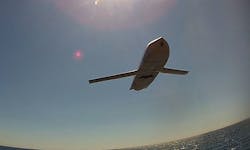Demonstration of new anti-ship missile nears end with $175 million contract to Lockheed Martin
ARLINGTON, Va., 18 March 2014. A U.S. military research program to develop an advanced anti-ship missile to replace the ageing Harpoon missile is nearing the end of its demonstration phase, and the program to develop and deploy the Long Range Anti-Ship Missile (LRASM) should switch over to the U.S. Navy by early 2016.
Officials of the U.S. Defense Advanced Research Projects Agency (DARPA) in Arlington, Va., announced plans Friday to award a two-year $175 million follow-on contract to the Lockheed Martin Corp. Missiles and Fire Control segment in Orlando, Fla., which has been developing LRASM for the last five years.
LRASM will rely on on-board targeting systems to acquire the target independently without the presence of prior, precision intelligence, or supporting services like Global Positioning Satellite navigation and data-links. The missile will be designed with advanced counter-countermeasures to evade hostile active defense systems.
The missile is being designed to fire from the Mk 41 Vertical Launch System on Navy surface warships, as well as from the U.S. Air Force B-1B Lancer supersonic bomber, and from the Navy F/A-18E/F Super Hornet carrier-based fighter-bomber. Submarine-launched versions are under consideration.
Related: Lockheed Martin moves closer to demonstrating Long Range Anti-Ship Missile (LRASM)
The upcoming LRASM follow-on research contract from DARPA will mature LRASM systems and technology. The planned research and development effort will complete the LRASM demonstration program, and has several components.
First, Lockheed Martin will continue developing the LRASM long-range targeting sensor, as well as the long-range sensor algorithms and software for advanced LRASM capability against specific high-priority targets in densely spaced groups of surface ships.
Then company missile experts will work on the LRASM missile-control unit to optimize processor throughput margin and address hardware obsolescence. Lockheed Martin also will refine the LRASM electro-optical terminal target sensor hardware software to demonstrate the missile's ability in poor visibility.
After that, Lockheed Martin engineers will work on missile autonomy, and mature LRASM situational awareness software. Finally, company experts will refine the LRASM's weapon data link to meet U.S. Navy requirements.
Related: How vulnerable are U.S. Navy vessels to advanced anti-ship cruise missiles?
As part of the upcoming follow-on contract, Lockheed Martin engineers also will integrate LRASM software with prototype sensor, guidance, and control hardware for extensive testing in a hardware-in-the-loop laboratory.
A separate component of the follow-on contract will ask Lockheed Martin engineers to develop and test the LRASM warhead fuze to address obsolescence and Navy insensitive-munitions issues.
Lockheed Martin also will conduct additional LRASM flight tests against surrogate targets from the Navy, with an eye to deploying LRASM on the Air Force B-1B bomber in 2018, and on the Navy F/A-18 carrier-based combat jet in 2019.
Last November Lockheed Martin conducted its second LRASM flight test in a launch from an Air Force B-1B bomber off the Southern California coast. Flying over the sea range at Point Mugu, Calif., a the B-1B bomber from the 337th Test and Evaluation Squadron at Dyess Air Force Base, Texas, released the LRASM, which navigated through all planned waypoints receiving in-flight targeting updates from the system's Weapon Data Link, Lockheed Martin officials say.
Related: Long range anti ship cruise missile to be designed by Lockheed Martin for DARPA
After switching to autonomous guidance, the LRASM identified the target using inputs from the onboard sensors, descended for final approach, verified the target, and hit it.
The Lockheed Martin LRASM has a 1,000-pound penetrator and blast-fragmentation warhead, multi-mode sensor, weapon data link, and enhanced digital anti-jam global positioning system to detect and destroy selected surface targets within groups of ships.
Lockheed Martin is in charge of LRASM overall development, and the BAE Systems Electronic Systems segment in Nashua, N.H., is developing the LRASM onboard sensor systems.
The program is expected to switch from DARPA to the Navy after this follow-on contract finishes in 2016. The Office of Naval Research (ONR) in Arlington, Va., also has been involved in LRASM development.
DARPA officials plan to award the follow-on contract sole-source to Lockheed Martin because competing the contract at this stage of development would be too difficult and expensive. The Raytheon Co. Missile Systems segment in Tucson, Ariz., and Kongsberg Defense & Aerospace AS in Kongsberg, Norway, had shown interest in this part of the LRASM program, but were turned down earlier this month, DARPA officials say.
The DARPA LRASM contract is in response to a gap in Navy anti-ship missile technology identified in 2008. The standard Navy anti-ship missile is the subsonic Harpoon, which has been in the inventory since 1977.
For more information contact Lockheed Martin Missiles and Fire Control online at www.lockheedmartin.com/us/mfc, DARPA at www.darpa.mil, BAE Systems Electronic Systems at www.baesystems.com, or the Office of Naval Research at www.onr.navy.mil.

